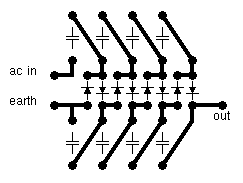10kV simple cascade
 This device is perfectly suited to start with, as it is not
dangerous and only requires some basic knowledge about soldering and
etching pcb's (or a friend who knows). It makes use of a type of
circuit called cascade (for obvious reasons):
This device is perfectly suited to start with, as it is not
dangerous and only requires some basic knowledge about soldering and
etching pcb's (or a friend who knows). It makes use of a type of
circuit called cascade (for obvious reasons):
 Each stage gives the peak-to-peak voltage of the ac input, so all
diodes an caps must be rated for at least this voltage. The sum of
all output voltages gives the final output voltage. Example: Given an input of
230 V eff, that is 650V pp, and a 10-stage-cascade, the output is
6.5kV. 10kV is a typical, easily reachable value. In
principle, the output voltage is arbitrary (you only have to use
enough stages); in practice, it's not, as the last stages only
get a small fraction of the input. More than perhaps 25 stages are not
sensible, and even then you cannot expect the theoretical output.
Each stage gives the peak-to-peak voltage of the ac input, so all
diodes an caps must be rated for at least this voltage. The sum of
all output voltages gives the final output voltage. Example: Given an input of
230 V eff, that is 650V pp, and a 10-stage-cascade, the output is
6.5kV. 10kV is a typical, easily reachable value. In
principle, the output voltage is arbitrary (you only have to use
enough stages); in practice, it's not, as the last stages only
get a small fraction of the input. More than perhaps 25 stages are not
sensible, and even then you cannot expect the theoretical output.
 Use a pattern like this (or develop your own!) and
etch as many stages as fit on a high quality (epoxy) pcb. For
each stage, you need two diodes (1N4007, 1000V) and two caps (630V,
capacitance as fits your etch-pattern and wallet). Connect an Earth
cable to the "earth" point of the first stage and an output terminal to
the "output" point of the last stage.
Use a pattern like this (or develop your own!) and
etch as many stages as fit on a high quality (epoxy) pcb. For
each stage, you need two diodes (1N4007, 1000V) and two caps (630V,
capacitance as fits your etch-pattern and wallet). Connect an Earth
cable to the "earth" point of the first stage and an output terminal to
the "output" point of the last stage.
For a safe input of about mains voltage, you should use two
transformers of the same type (low voltage!) and connect the two
secondaries, thus procducing a primitive "mains insulation
transformer". Only a few VA will do. Connect one of the primaries to
the mains, the other one
to the input of your cascade, the earth cable to a water tap or
central heating pipe, and there you go!
Hints:
Always earth your device, otherwise the transformer's insulation might
be damaged. And, of course, keep clear of mains voltage.
[Back to Index]
[Other links]
Jochen
Kronjaeger
Kronjaeg@stud-mailer.uni-marburg.de



 Use a pattern like this (or develop your own!) and
etch as many stages as fit on a high quality (epoxy) pcb. For
each stage, you need two diodes (1N4007, 1000V) and two caps (630V,
capacitance as fits your etch-pattern and wallet). Connect an Earth
cable to the "earth" point of the first stage and an output terminal to
the "output" point of the last stage.
Use a pattern like this (or develop your own!) and
etch as many stages as fit on a high quality (epoxy) pcb. For
each stage, you need two diodes (1N4007, 1000V) and two caps (630V,
capacitance as fits your etch-pattern and wallet). Connect an Earth
cable to the "earth" point of the first stage and an output terminal to
the "output" point of the last stage.